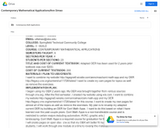
Full course on Contemporary Mathematical Applications.
- Subject:
- Mathematics
- Material Type:
- Full Course
- Provider:
- Springfield Technical Community College
- Author:
- Ann Simao
- Date Added:
- 05/15/2019

Full course on Contemporary Mathematical Applications.
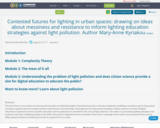
The three-hour course draws on educational concepts of rethinking higher educational practices towards complexity modelling, messiness and to bring about resistance against reductive simple systems of governance that privilege a homogenous one directional viewpoint. Citizen science as a form of digital education is explored in terms of public education and its application is extended to the area of light pollution. The author is a practising lighting designer and professor and chair of lighting design at the OWL University of Applied Sciences, Germany. This work is copyright of the author and licensed for free use by OER commons however attribution of work is required if it is re-used.
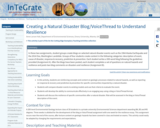
Student groups create blogs or VoiceThreads on selected natural disaster events including a description of the event, the cause of the disaster, response & recovery, prediction & prevention and resilience to the event.
(Note: this resource was added to OER Commons as part of a batch upload of over 2,200 records. If you notice an issue with the quality of the metadata, please let us know by using the 'report' button and we will flag it for consideration.)

This module offers school principals and school librarians the opportunity to build and strengthen understanding and skills toward collaborative instruction with the school librarian and classroom faculty. This module is also appropriate for graduate candidates in school leadership and/or school librarian programs.This module is based on the British University learning model. In England, Small groups of learners meet once a week with a "tutor" - AKA professor to discuss relevant topics, share their work, submit assignments and get feedback. While the faculty suggests resources, learners are expected to conduct research to find their own. This model is especially applicable to school library and school principal candidates who need to build research skills for on-going professional development in the field. Librarians, of course, always need to hone their research skills.Like the British model, learning for this program is largely self-guided. Resources are provided for the learner to develop expertise demonstrated in three major assignments: a white paper, a tri-fold pamphlet, and an analysis of a case study.Candidates must demonstrate and justify competence in targeted ISLLC and ALA Standards to successfully complete the module. This competence is assessed by a rubric used by the candidate for self-assessment and by faculty for performance assessment .Because the learning for this module is largely self-guided, faculty needs to be available for consultation through regularly scheduled office hours and email. The goal of this consultation is to provide coaching and explanation. Faculty will use the Discussion Board Task as formative assessment to guide facilitated instruction and coaching. Summative assessment is demonstrated by the three artifacts produced in the module.
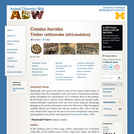
Crotalus horridus: Information

Cygnus atratus: Information
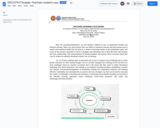
CPE/DPE
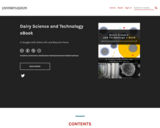
This is a textbook for learning about dairy science and technology.

Damaliscus pygargus: Information
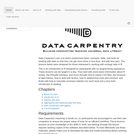
Data Carpentry lesson from Ecology curriculum to learn how to analyse and visualise ecological data in R. Data Carpentry’s aim is to teach researchers basic concepts, skills, and tools for working with data so that they can get more done in less time, and with less pain. The lessons below were designed for those interested in working with ecology data in R. This is an introduction to R designed for participants with no programming experience. These lessons can be taught in a day (~ 6 hours). They start with some basic information about R syntax, the RStudio interface, and move through how to import CSV files, the structure of data frames, how to deal with factors, how to add/remove rows and columns, how to calculate summary statistics from a data frame, and a brief introduction to plotting. The last lesson demonstrates how to work with databases directly from R.
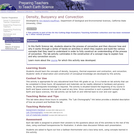
This 3-hour hands-on guided-discovery lab activity teaches students the concepts of density, buoyancy, thermal expansion and convection.
(Note: this resource was added to OER Commons as part of a batch upload of over 2,200 records. If you notice an issue with the quality of the metadata, please let us know by using the 'report' button and we will flag it for consideration.)
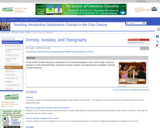
Show caption
HideA critical component of this activity involves sharing team data with the entire class, done the old-fashioned way on the chalkboard. Details This activity begins with an exploration of a topographic map of the earth, ending with the question: Why is the distribution of topography on the earth bimodal? The students then collect two forms of data. They measure the density of the most common rocks that make up oceanic crust (basalt), continental crust (granite), and the mantle (peridotite). They also measure the density of several different kinds of wood, and how high each kind floats in a tub of water. In each case, they work in teams of two or three and then the entire class shares their data. Based on the data from the wood, they derive an equation that relates the density of the wood to the height at which the block floats in the water - the isostasy equation. They then substitute density values for real rocks into their equation to derive thicknesses for average continental and oceanic crust, and apply their knowledge in order to draw a cross-section of the crust across South America. This activity gives students a real, hands-on and mathematical understanding of the principle of isostasy.
(Note: this resource was added to OER Commons as part of a batch upload of over 2,200 records. If you notice an issue with the quality of the metadata, please let us know by using the 'report' button and we will flag it for consideration.)
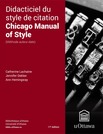
Short Description:
Ce didacticiel du style de citation Chicago est une adaptation du didacticiel d’introduction à la APA en français de la Bibliothèque de l’Université de l’Alberta. Il a été créé par le personnel de la bibliothèque de l'Université de d'Ottawa dans le but d'offrir une ressource en français aux étudiants et aux professeurs qui utilisent ce style dans leurs champs d'études et de recherches.
Long Description:
Le didacticiel discute de l’importance des citations et explique en détails les principaux éléments des références et des citations dans le texte d’après les directives de la 17e édition du manuel du style de citation Chicago. Une lecture en profondeur d’au moins une heure et demie est nécessaire pour atteindre les objectifs d’apprentissage. Ce didacticiel peut également être utilisé comme ressource de référence.
Word Count: 3025
(Note: This resource's metadata has been created automatically by reformatting and/or combining the information that the author initially provided as part of a bulk import process.)
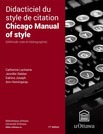
Short Description:
Ce didacticiel du style de citation Chicago est une adaptation du didacticiel d’introduction à la APA en français de la Bibliothèque de l’Université de l’Alberta. Il a été créé par le personnel de la bibliothèque de l'Université de d'Ottawa dans le but d'offrir une ressource en français aux étudiants et aux professeurs qui utilisent ce style dans leurs champs d'études et de recherches.
Long Description:
Le didacticiel discute de l’importance des citations et explique en détails les principaux éléments des références et des citations dans le texte d’après les directives de la 17e édition du manuel du style de citation Chicago. Une lecture en profondeur d’au moins une heure et demie est nécessaire pour atteindre les objectifs d’apprentissage. Ce didacticiel peut également être utilisé comme ressource de référence.
Word Count: 3537
(Note: This resource's metadata has been created automatically by reformatting and/or combining the information that the author initially provided as part of a bulk import process.)

This sequenced collection, curated by Seattle Public School educators, contains openly-licensed Digital Citizenship resources for K-5 educators.

How will online posts affect your future?What impact does digital footprints have on scholarships, careers?Do businesses and companies look to people’s online presence when selecting employees to hire?
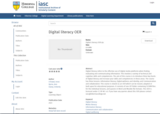
Digital literacy refers to the effective use of digital media platforms when finding, evaluating and communicating information. This involves a variety of technical and cognitive skills and competencies. The aim of this course is to introduce three key facets of digital literacy and increase your skills and competencies in these areas.
The course has three lessons: Information literacy
Digital wellness and identity
Communication and collaboration
This course is shared as an OER which can be reused, adapted or built upon for educational purposes.
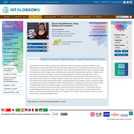
Scientists who are working to discover new medicines often use robots to prepare samples of cells, allowing them to test chemicals to identify those that might be used to treat diseases. Students will meet a scientist who works to identify new medicines. She created free software that ''looks'' at images of cells and determines which images show cells that have responded to the potential medicines. Students will learn about how this technology is currently enabling research to identify new antibiotics to treat tuberculosis. Students will complete hands-on activities that demonstrate how new medicines can be discovered using robots and computer software, starring the student as ''the computer.'' In the process, the students learn about experimental design, including positive and negative controls.
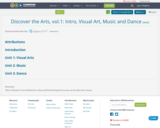
This is Volume 1 of a textbook for a Fine and Performing Arts survey, an introductory course.
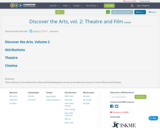
This is Volume 2 of a textbook for a Fine and Performing Arts survey, an introductory course. It covers Theatre and Cinema.